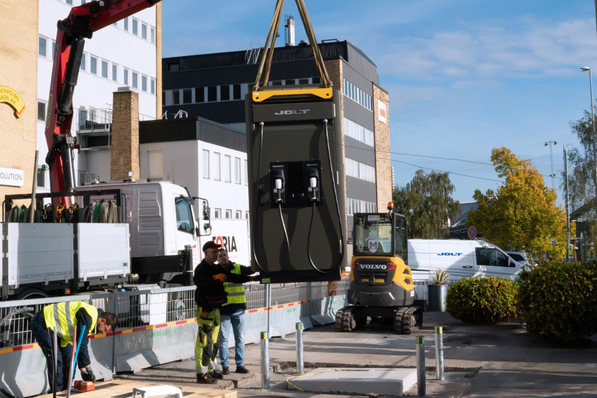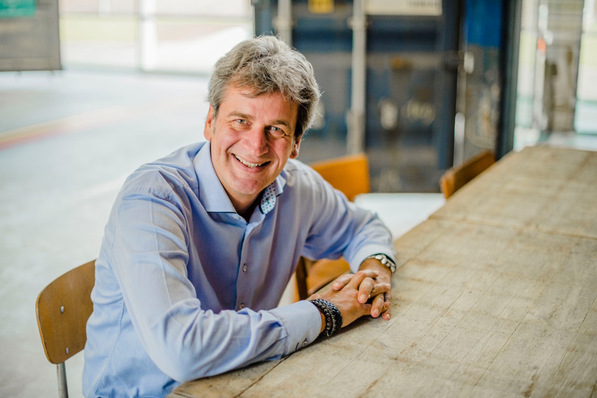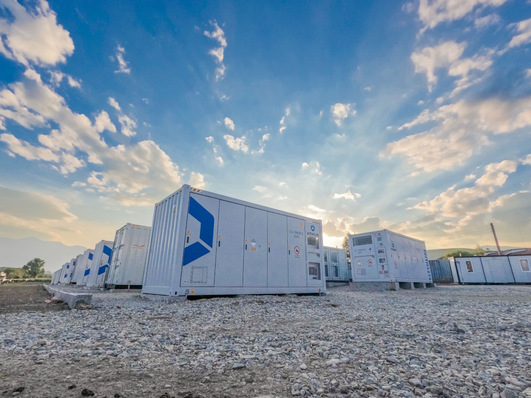This former supermarket in Mainz Gonsenheim was to be brought back to life after 13 years of vacancy. There were plenty of ideas what to do with this property, the most simple one being just to tear it down and build an amusement arcade in its place. But when Alexander Maier saw the dilapidated building, he knew right away: “This would be a great place for our offices.”
Maier is an architect and Gonsenheim is a slightly more sophisticated area, where either a ruin or an arcade is a little out of place. It was like love at first sight for Maier, but it ended up taking ten years for him to get the necessary change of use and rebuilding permits.
A new lease of life for this temple to consumerism
And so this former temple to consumerism was turned into a modern residential property where Maier has been living and operating his architecture practice Zeit + Raum. The three additional flats that he also built were quickly let out.
One thing that is not obvious from the outside: The building, albeit not altered structurally, is an object lesson for energy-saving renovation and clean energy supply. It is based around 76 Panasonic solar panels (HIT technology) that were mounted to the flat roof and cannot be seen from ground level. Combining that with battery storage by Tesla results in a high degree of self-sufficiency for the office.

Electric mobility is an indispensable part of it all
Alexander Maier comes from a family of architects. He is the third generation to design and build houses, and he has a passion for modern technology. So he was convinced early on in this project that he would include many innovations. “Old-fashioned and traditional thinking scares me,” the 53-year-old says. “If it is possible today for buildings to generate power, this should be done.” That electric mobility should be a part of it was obvious to him.
The goals quickly emerged as part of the planning process: First of all, Maier wanted to maintain the building in its original shape. Further, he wanted to meet the KfW standards, albeit without ventilation. And the building was to generate more power than his offices would require. And best of all: None of the technology was to be visible from the outside. Maier calls this ‘invisible energy generation’.
It all started with insulation
And here are the steps: In order to comply with KfW’s efficient building standard 85, the building had to be well-insulated. The floor screed was renewed and 16 centimetres of insulation added. The walls were also lined with 16 centimetres of insulation, whereas the roof was given 30 centimetres of mineral wool. The triple-glazed windows have a U-value of 0.9 watts per square metre and degree kelvin in temperature difference.
He completely gutted the former supermarket and planned three flats in addition to his office. Two are on the ground floor and one is on the upper floor above the office. The add up to a total living area of 400 square metres. The architecture office has about 300 square metres of floor space, 200 on the ground floor and 100 in the basement.
Well-hidden solar panels
The aim of the energy concept was to take as little power from the grid as possible while using as much renewables as possible. So Maier had the specialist installing company Sonnenkönig from Nieder-Olm install an 18.62-kilowatt photovoltaics array on the flat roof. The 76 panels are mounted in an east-west orientation and at an inclination of ten degrees. “I chose the HIT panels because they are the most efficient,” Maier says to explain his decision. With these Japanese panels, a monocrystalline wafer is covered by an amorphous layer of silicon. This makes these panels very efficient. As they are hidden behind the parapet wall, the panels can only be seen from the other side of the street – and that only by a keen-eyed observer.
57 percent self-sufficiency
The PV array went into operation in April 2016. It generates about 20,000 kilowatt hours per year. The architecture office uses up about 12,000 kilowatt hours, including complete climate control, LED lighting and the IT systems. The installation thus generates an annual surplus of about 8,000 kilowatt hours. Because Maier wanted to self-consume as much of the solar power as possible, he also installed a Tesla Powerwall (6.4 kilowatt hours of capacity). By combining PV and the solar battery in this way, he was able to use 55 percent of his own electricity in the 12 months until May of this year. He therefore achieved 57 percent self-sufficiency, leaving him with 43 percent of consumption of grid power.
A filling station out front
To provide heating, a Stirling cogeneration unit with 25 kilowatts thermal output and one kilowatt electrical output was installed. Maier also had a heat pump fitted. “I turn on the heat pump in the summer, in order to cool the building,” he explains. This allows him to make better use of the solar power in the hottest part of the year when the PV array generates a lot of electricity.
The overall amount of electricity consumed is about 14,000 kilowatt hours per year, also because Maier drives a Tesla. He has long been won over by the innovative technology that is taking over from internal combustion, and he can substantiate that argument by comparing cost: In his EV, 100 kilometres cost only 2,20 euros, while for the same distance he would have to pay 10,40 euros in petrol. He has had two charge points installed in front of the building, one of which is for his employees or visitors.
Fascinated by smart home technology
As a fan of this kind of technology, Maier has also had his office fitted with smart home technologies. This allows him to control the LED lighting as well as music, building services and energy monitoring. All individual systems are connected through one user interface.
After one year in his new home, Alexander Maier’s overall impression is quite positive. And so he intends to go ahead with the extensions that he had had in mind all along: The solar array is to be extended to 50 kilowatts. There is still some room on the rear part of the roof over the two flats. He also wants to buy two more solar batteries, boosting the capacity of three-phase storage to 38.7 kilowatt hours. The two charge points are to be joined by four more. Maier plans to completely convert his fleet to fully electric vehicles. By the end of 2018, he wants to have three electric company cars. And he plans to supply the building next door (which he also owns) via a remote heating feed. “The efficient use of clean energy has become an important part of my life,” Alexander Maier says. And integrating such sophisticated technology in such a way that it remains invisible gives him even greater joy. (Heike Rost)
Read more about energy storage
Stay informed, get our free newsletter twice a week. Register here.







